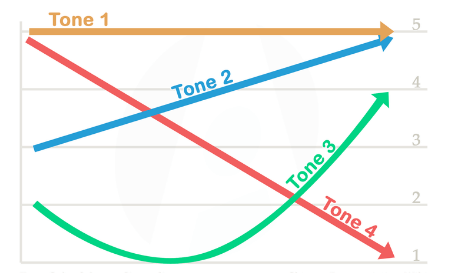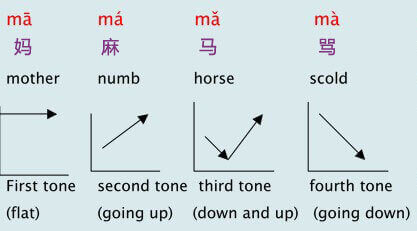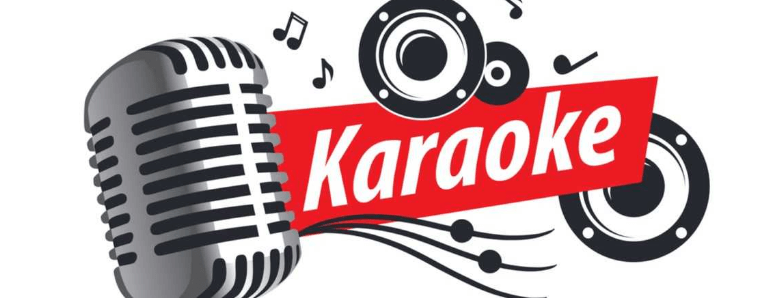How to Speak Chinese – The Chinese Tones
When learning a new skill, especially a new language it’s typical to make mistakes. After all how else are we supposed to improve! When I think back to my past embarrassing Chinese language fails one occasion stands above the others. It has to do with Chinese tones!
In every speaking class our teacher would make us practice Chinese tones. Our teacher would read out a word or character and we would have to guess what tone she was using. Then she would reverse it and we would have to read words out loud and have our tones corrected. In the class there was a weekly ranking. Through repetition I’d gotten quite good at speaking like a parrot and mimicking words I already knew. However, any new words I learn were problematic for me to speak to at first. I constantly complained about how useless learning tones were. But had to eat my words. There’s nothing like trying to ask a subway officer for “How far is the horse riding school?”, only for them to laugh… and call their colleagues over to laugh too!
Tones are important!

How to speak Chinese tones?
Are there are rules when using tones?
Tones are the foundation to being able to speak and understand spoken Chinese. Without them not only are you lost listening to conversations but also no one is able to understand you. Now for the good news, getting tones right is not that difficult if you practice and use a good approach and useful resources.
In total there are four tones. I’m going to use ‘Ma’ the word whose tone I got wrong and caused that confusion years ago to illustrate this.
- First tone: a flat high pitch tone, e.g. 妈, ma1, mum. Like a singer practicing ‘Fa’.
- Second tone: a rising tone, start from a low to a high pitch, e.g. 蟆, ma2, toad. As if you are asking a question.
- Third tone: fall and rise, start at a neutral tone then dip lower and end in a high pitch, e.g.马, ma3, horse. Imagine you are surprised.
- Fourth tone: falling tone, start at a high pitch and strongly drop the pitch down, e.g. 榪,ma4, headboard. My favorite tone, you just sound angry!
- There is also a neutral tone.

When using tones there are 3 special rules you need to take into consideration?
- Rule one: It’s very simple when there are two third tones in a row, the first one becomes second tone. For example,你好 (ni3hao3 ) when spoken becomes 你好 (ni2hao3).
- Rule two: Relating to a very important word, 不(bú) or no! When the word 不 (bù) precedes a fourth tone, 不 changes to second tone (bú). For example, 不对 (bùduì) when spoken becomes不对 (búduì).
- Rule three: Again based on a character, this time the character one or 一 (yī ) in Chinese. This character when alone has a 1st tone, second tone when followed by a fourth tone, and fourth tone when followed by any other tone.
How to learn Chinese tones more effectively?
Access to Native speakers
When learning tones getting them right from the start is very important. No app can ever truly replace interaction with a native speaker. I get it though, it’s not like we can all uproot our lives and move to China just to learn Chinese. Lingo bus offers the perfect solution for children aged between 5 and 12 years old. Not only are all our teachers Chinese native speakers but our classes are designed to create a fun and engaging atmosphere. Students will be getting their tones right before even noticing they are practicing them! Check out to find top 5 language learning games to help Children learn Chinese.

Apps
I know that some of you already have accessed our fantastic classes. But may want to offer further support to your children, or even study tones yourself! The first step to improving tones is recognition. Being able to speak with the correct tones is difficult if you can’t recognize them to begin with. Although I found this monotonous when I was a student, it’s a basic foundation skill to how to speak Chinese. Thankfully there are many apps out there focusing on tones to make it fun. An example is Standard mandarin, which has a very useful feature that tells you what facial muscles you should be using.
Films, podcast, videos
There are many free resources on online platforms such as Youtube, Youku, BBC, etc, to help students practice tones. Podcasts or audiobooks can also help as you can listen and repeat from the text. They also help to reinforce grammar points and language structure. However, these don’t offer any feedback. For feedback you can download Chinese language apps that include speaking practice, for example ‘HelloChinese’. Apps like these have software that recognizes if you are using the correct tones or not!

Karaoke
Once you have begun to recognize tones the next step is to be able to use them. Initially the best way to practice is through mimicking. Like we mentioned above there are many apps for this. But should you need a change, I suggest a favorite Chinese activity, karaoke! Tones in essence make Chinese sound like a very lyrical language. It’s almost like you are always singing. A lot of apps focus on single words, by singing you will be practicing switching tones frequently in a sentence.
It may seem like a task at first but tones are extremely important, the key is not to rush but enjoy the process of learning and experimenting with tones. Have fun learning how to use tones to improve your Chinese! Why teaching and learning are shifting from traditional classroom settings to online learning platform? It’s pretty easy to see why.

Request a Free Live Chinese Class for Your Children
Copyright Notice: Everyone is welcome to forward the articles in this blog as long as the links to these articles are also included.

